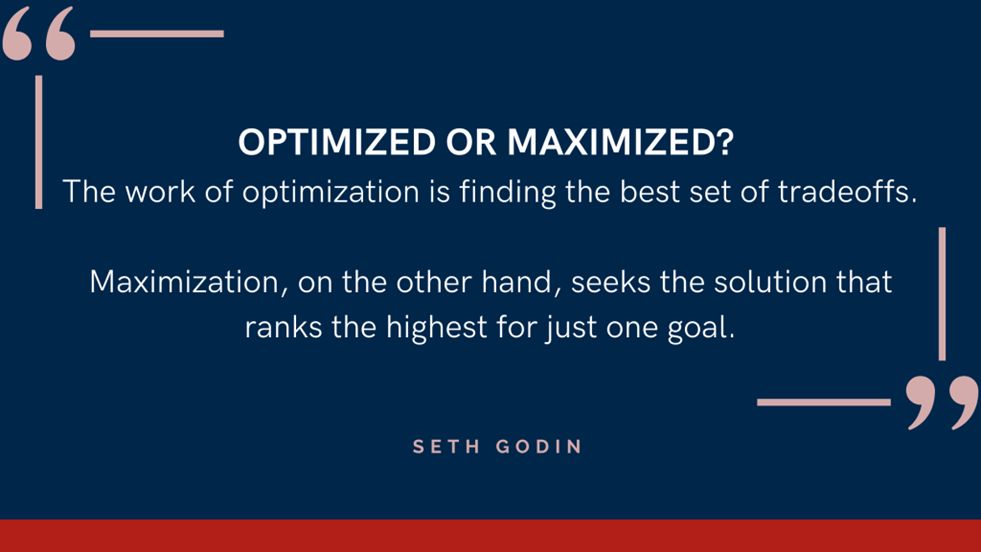
In commercial strategy, the concepts of “maximize” and “optimize” play a crucial role in the success of a hotel. Although both terms refer to strategies aimed at improving profitability and asset value, they do it in different ways, each with its own implications.
Maximizing Revenue: A Narrow Focus
Maximizing revenue, often measured by metrics like RevPAR index, can lead to a singular focus on specific outcomes such as high occupancy or ADR wins. Reaching or exceeding a RevPAR index of 100 indicates that a hotel’s performance has reached the average performance of an aggregated group of competitors, with which you may or may not directly compete for all types of business on all days of the week. High RevPAR index performance and ranking can illustrate occupancy or ADR success, but rarely both. This approach often comes at the expense of overall profit. It tends to be driven by models of success that are narrowly focused (RevPAR index, “fair share”, etc.), however, they do not consider the full complement of demand or the true range of competitors, and it does not put emphasis on directing resources to lead to the most profitable performance for the hotel. “Prior to the digital boom, the hotel landscape was less crowded, and the playbook for driving demand was pretty straightforward. Costs were predictable, leveling out at around 5% year over year, and as you boosted sales, profits followed suit with little trouble. Chasing the highest revenue was the primary goal, and it seemed to just “work out”. Fast forward to now, and there are many more layers. We’re navigating a maze of demand generators, a busy digital market, and lots of competition in marketing. Commercial strategy teams have to be savvy, weighing where every dollar and minute goes to make sure they’re banking the most profit. It’s about smart plays, not just big numbers.
Optimizing Profitability: A Holistic Approach
As times have changed in a more complex market dominated by high-cost digital intermediaries, top line revenue doesn’t flow through to profit the way it once did. Operations teams face competing demands for resources to pay rising debt service, labor, insurance, and taxes, not to mention the now whopping 15-25% of guest paid revenue required for customer acquisition. A commercial strategy approach must consider a variety of factors that lead to the most profitable business mix possible, such as cost of acquisition, demand in the market that is a fit for the subject hotel, and casting a wider net across all competitors, not just those in a traditional comp set. Why would a hotel choose to limit its options for good opportunities? Commercial strategy effectively guides deployment of sales, marketing, merchandising, and digital resources by making tradeoffs between commercial investments and accepts that few hotels can afford to pursue all opportunities. It is purpose-built to result in higher profits, leads to increased asset value, and lays the foundation for a stronger competitive advantage. This approach calls for close collaboration between sales, revenue, marketing, and operations with intentional decisions about choosing the most profitable business mix and the ultimate goal of growing asset value.
Tying it Together: Meeting Space as an Analogy
To illustrate the difference between maximizing and optimizing, let’s consider the use of meeting space in a hotel. A “maximize” mindset might lead to rigid space utilization, focusing solely on high occupancy or rental rates, or waiting too long to rent to “space-only” customers while waiting for non-existent groups with catering needs to call the sales department. In contrast, an “optimize” approach would consider factors such as flexibility in usage, offering a variety of setups to cater to different client needs, and ultimately maximizing the profitability of the space through a more holistic and dynamic strategy. It would focus the team on proactive activities designed to identify and pursue the best fit for the meeting space.
Similarly, optimizing the business mix of a hotel allows a commercial strategy team to embrace flexibility and collaboration to achieve the greatest possible outcomes. By understanding and embracing optimization principles, hotels can drive sustainable profitability and long-term success in an increasingly competitive market.
The difference between maximizing and optimizing in commercial strategy is in the approach taken to achieving financial goals. While maximizing revenue may lead to a narrow focus on specific metrics, optimizing profitability takes a more holistic and dynamic approach. This is done by considering various factors to achieve the best possible outcomes. While we’ve relied on maximizing in the past, we must now transition to embracing an optimization mindset for long-term success.

